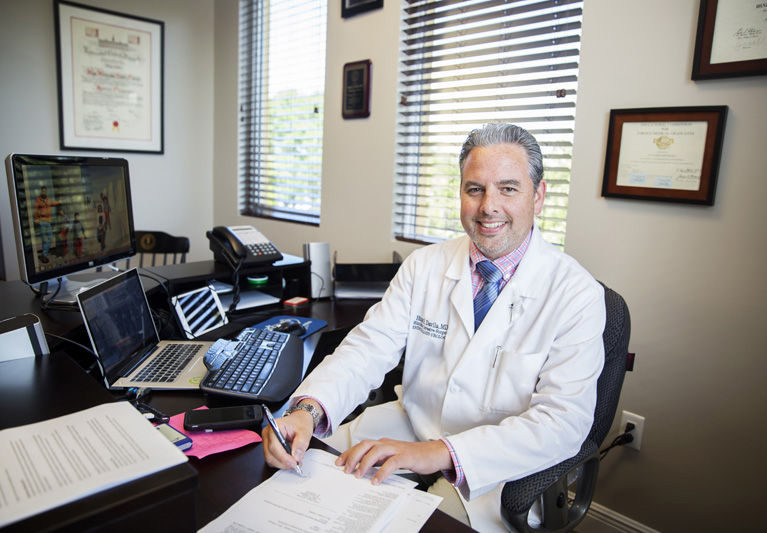
Kidney stones are the most common urinary tract problem in the world. According to the Urology Care Foundation, more than a million Americans will develop a kidney stone this year.
Kidney stones – which can be incredibly painful – account for more than two million visits to physicians’ offices and upwards of 600,000 emergency room trips annually. All told, the UCF says kidney stones cost the economy just over almost $5.3 billion each year in diagnosis, treatment and lost time from work.
Dr. Hugo Davila of Indian River Urology Associates and the Sebastian River Medical Center knows the full story behind kidney stones better than most. After medical school in Venezuela, Davila did his internship and residency at the University of South Florida in Tampa and his post-graduate work at UCLA, following in his father’s foots
In simple terms, the urinary tract is the body’s drainage system. It removes waste and extra water. The tract consists of two kidneys, two ureters, the bladder and the urethra.
The kidneys are two fist-sized organs just below the rib cage near the middle of the back. When functioning normally they filter about 200 quarts of blood per day, producing between one and two quarts of urine. That urine then flows to the bladder through twin, thin tubes called ureters that are between eight and 10 inches long. When the bladder is emptied, urine flows out of the body through another tube called the urethra.
Unless it can’t.
Kidney stones, for example, can block the flow of urine from the kidneys into the ureters causing severe pain in the side and back which often spreads to the lower abdomen and groin.
Kidney stones are actually less “stones” than they are crystals. Mineral deposits that form inside the kidneys due to excessive levels of salt, calcium, oxalate or uric acid bind together to form these crystals. If they grow large enough they can block the flow of urine anywhere in the urinary tract.
One thing that clearly concerns Davila is that the number of people in the U.S. developing kidney stones appears to be on the rise.
In 1980, Davila says, about three in every 100 people got a kidney stone at some point in their life. In 1994, that number had risen to about five in every 100 people and by 2010, almost nine in every 100 people developed kidney stones in their lifetime. Even more disturbing to this affable specialist with the lilting Latin accent is that he says more and more children and teenagers are getting kidney stones today.
While the Mayo Clinic claims, “kidney stones often have no definite single cause,” Davila has other ideas. He places much of the blame on the foods we eat, the amount of water we don’t drink and the excessive consumption of salt or salty foods.
Fortunately for those one million people who will develop a kidney stone this year, the diagnosis and treatment for “nephrolithiasis,” (the medical term for kidney stones), has radically improved over the years according to Davila.
Not long ago the only viable treatment was consuming so much water that the stones were literally forced out of the urinary tract, no matter how painful that was.
Then in the 1980s a new procedure called “shock wave lithotripsy” was introduced. About 1,000 to 2,000 shock waves were aimed at the urinary tract causing stones to fragment into smaller pieces. Some physicians still use this procedure but there’s a definite downside. Those fragmented pieces still must pass through the rest of the urinary tract to be expelled. The closer the stone is to the kidney, the further those fragments have to travel and the greater the potential for a painful passage.
Now, according to Davila, there’s a better option.
Using what Davila calls, “the absolute best” equipment available, stones are now detected using ultra-sound, x-rays or “low dose protocol” CAT scans. “Once we make that diagnosis,” explains Davila, “kidney stones are like real estate. [Treatment is] all about location, location, location.” In other words, knowing how high up in the urinary tract the stone or stones are, how big they are and how far they have to travel to be expelled makes for a far more precise approach to dealing with them.
Specifically, Davila points to SRMC’s newest high-definition Olympus cameras inside long, tube-like tools called endoscopes or ureter scopes which allow him to directly target stones, break them up using laser energy, (rather than external shockwaves), and collect the fragments using a “stone basket.”
By collecting and removing the stone fragments himself, his patients don’t have to risk the pain of passing those fragments through the urethra days or weeks later.
Like most physicians, Davila is as keen on prevention as he is treatment. To that end, he worked with a nutritionist to develop an 11-page, easy to follow collection of menu suggestions and recipes for kidney stone prevention.
With or without the recipes, however, Davila’s top tips are to cut down on salt intake, consume less red meat and to drink more water. (Though he advises people not to select the flavored varieties of water currently on the market.)
“Two to three liters”, (roughly a half gallon), “of plain water a day,” says Davila should be the goal in order to help prevent kidney stones.
Dr. Hugo Davila is with Indian River Urology Associates and Sebastian River Medical Center. His office is at 1627 U.S. Hwy. One, Suite 201 in Sebastian. The number is 772-388-8858.



